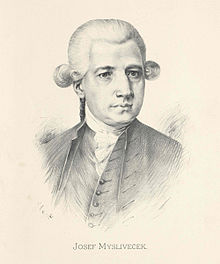Ezio (Mysliveček, 1775)

Ezio is an eighteenth-century Italian
Performance history
The opera was first performed at the
Connection with Mozart
The musicologist Daniel E. Freeman has demonstrated that Mozart used Mysliveček's scene and aria, "Misera, dove son?/Ah, non so io che parlo," as a partial model for his own setting of the same texts, K. 369.[2]
Roles
| Role | Voice type | Premiere cast, 30 May 1775, Teatro San Carlo, Naples |
|---|---|---|
| Valentiniano III, emperor of Rome, in love with Fulvia | soprano castrato | Giuseppe Benedetti |
| Fulvia, daughter of Massimo, a Roman patrician, in love with Ezio and betrothed to him | soprano | Anna de Amicis-Buonsollazzi |
| Ezio, general of the imperial armies, in love with Fulvia | soprano castrato | Gaspare Pacchierotti |
| Onoria, sister of Valentiniano, secretly in love with Ezio | soprano | Elisabetta Ranieri |
| Massimo, Roman patrician, father of Fulvia, confidant and secret enemy of Valentiniano | tenor | Arcangelo Cortoni |
| Varo, prefect of the Praetorian guard, friend of Ezio | soprano castrato | Nicola Lancelotti |
Vocal set pieces
Act I, scene 2 - Aria of Valentiniano, "Se tu la reggi al volo"
Act I, scene 3 - Aria of Ezio, "Pensa a serbarmi, o cara"
Act I, scene 4 - Aria of Varo, "Più lieti imagini" [a non-Metastasian text]
Act I, scene 5 - Aria of Fulvia, "Caro padre, a me non dei"
Act I, scene 6 - Accompanied recitative for Massimo, "Che sventura è la mia"
Act I, scene 6 - Aria of Massimo, "Il nocchier che si figura"
Act I, scene 8 - Aria of Onoria, "Quanto mai felici siete"
Act I, scene 12 - Accompanied recitative for Ezio and Fulvia, "Fu questo il primo oggetto"
Act I, scene 12 - Duet for Ezio and Fulvia, "Mia vita, se m'ami" [a non-Metastasian text]
Act II, scene 3 - Aria of Valentiniano, "Vi fida lo sposo"
Act II, scene 4 - Aria of Massimo, "Va, dal furor portata"
Act II, scene 6 - Aria of Ezio, "Recagli quell'acciaro"
Act II, scene 7 - Aria of Varo, "Mostra per poco almeno" [a non-Metastasian text]
Act II, scene 9 - Aria of Onoria, "Fin che per te mi palpita"
Act II, scene 11 - Aria of Ezio, "Caro mio bene, addio"
Act II, scene 12 - Aria of Valentiniano, "A tuo dispetto ingrata" [a non-Metastasian text]
Act II, scene 13 - Accompanied recitative for Fulvia, "Misera, dove son?"
Act II, scene 13 - Aria of Fulvia, "Ah, non son io che parlo"
Act III, scene 2 - Aria of Ezio, "Mi dona, mi rende" [a non-Metastasian text]
Act III, scene 6 - Aria of Massimo, "Tergi l'ingiuste lagrime"
Act III, scene 7 - Aria of Fulvia, "Dei clementi amici" [a non-Metastasian text]
Score
The complete score of Mysliveček's Ezio of 1775 is available for study online on the Italian website Internet Culturale in the form of a reproduction of a manuscript once in the possession of the Teatro San Carlo of Naples.
See also
References
- ^ Detailed documentation concerning the Naples performance of Mysliveček's Ezio of 1775 is found in Daniel E. Freeman, Josef Mysliveček, "Il Boemo" (Sterling Heights, Mich.: Harmonie Park Press, 2009).
- ^ See Daniel E. Freeman, "Music for the Noble Amateur: Mozart's Scene and Aria 'Misera, dove son?/Ah, non so io che parlo,' K. 369," in Mozart-Jahrbuch 2000 (Kassel: Bärenreiter, 2002): 47-71.
External links
Complete score in manuscript available for viewing and downloading at http://www.internetculturale.it (Subcategory: Digital Contents)
